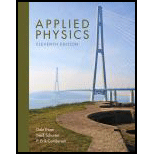
Applied Physics (11th Edition)
11th Edition
ISBN: 9780134159386
Author: Dale Ewen, Neill Schurter, Erik Gundersen
Publisher: PEARSON
expand_more
expand_more
format_list_bulleted
Textbook Question
Chapter 1.3, Problem 35P
Write each number in decimal form.
35. 8.4 × 10–6
Expert Solution & Answer
Want to see the full answer?
Check out a sample textbook solution
Students have asked these similar questions
Please keep all decimals
Need help. Answer in decimal format not Scientific notation
Round off to 4 digits
Chapter 1 Solutions
Applied Physics (11th Edition)
Ch. 1.2 - Give the metric prefix for each value. 1. 1000Ch. 1.2 - Give the metric prefix for each value. 2. 0.01Ch. 1.2 - Give the metric prefix for each value. 3. 100Ch. 1.2 - Give the metric prefix for each value. 4. 0.1Ch. 1.2 - Give the metric prefix for each value. 5. 0.001Ch. 1.2 - Give the metric prefix for each value. 6. 10Ch. 1.2 - Give the metric prefix for each value. 7....Ch. 1.2 - Give the metric prefix for each value. 8. 0.000001Ch. 1.2 - Give the metric symbol, or abbreviation for each...Ch. 1.2 - Give the metric symbol, or abbreviation, for each...
Ch. 1.2 - Give the metric symbol, or abbreviation, for each...Ch. 1.2 - Prob. 12PCh. 1.2 - Give the metric symbol, or abbreviation, for each...Ch. 1.2 - Give the metric symbol, or abbreviation, for each...Ch. 1.2 - Prob. 15PCh. 1.2 - Give the metric symbol, or abbreviation, for each...Ch. 1.2 - Prob. 17PCh. 1.2 - Prob. 18PCh. 1.2 - Write the abbreviation for each quantity. 19. 28...Ch. 1.2 - Prob. 20PCh. 1.2 - Write the abbreviation for each quantity. 21. 49...Ch. 1.2 - Prob. 22PCh. 1.2 - Write the abbreviation for each quantity. 23. 75...Ch. 1.2 - Write the abbreviation for each quantity. 24. 15...Ch. 1.2 - Prob. 25PCh. 1.2 - Write the SI unit for each abbreviation. 26. 185 LCh. 1.2 - Write the SI unit for each abbreviation. 27. 59 gCh. 1.2 - Write the SI unit for each abbreviation. 28. 125...Ch. 1.2 - Write the SI unit for each abbreviation. 29. 27 mmCh. 1.2 - Write the SI unit for each abbreviation. 30. 25 dLCh. 1.2 - Prob. 31PCh. 1.2 - Write the SI unit for each abbreviation. 32. 27 mgCh. 1.2 - Write the SI unit for each abbreviation. 33. 26 MmCh. 1.2 - Write the SI unit for each abbreviation. 34. 275 gCh. 1.2 - The basic metric unit of length is ______.Ch. 1.2 - The basic unit of mass is _______.Ch. 1.2 - Two common metric units of volume are ______ and...Ch. 1.2 - The basic unit for electric current is _______.Ch. 1.2 - Prob. 39PCh. 1.2 - The common metric unit for power is ______.Ch. 1.3 - Write each number in scientific notation. 1. 326Ch. 1.3 - Write each number in scientific notation. 2. 798Ch. 1.3 - Write each number in scientific notation. 3. 2650Ch. 1.3 - Write each number in scientific notation. 4....Ch. 1.3 - Write each number in scientific notation. 5. 826.4Ch. 1.3 - Write each number in scientific notation. 6. 24.97Ch. 1.3 - Write each number in scientific notation. 7....Ch. 1.3 - Write each number in scientific notation. 8....Ch. 1.3 - Write each number in scientific notation. 9. 6.43Ch. 1.3 - Write each number in scientific notation. 10....Ch. 1.3 - Write each number in scientific notation. 11....Ch. 1.3 - Write each number in scientific notation. 12....Ch. 1.3 - Write each number in scientific notation. 13....Ch. 1.3 - Write each number in scientific notation. 14....Ch. 1.3 - Write each number in scientific notation. 15....Ch. 1.3 - Write each number in scientific notation. 16....Ch. 1.3 - Write each number in scientific notation. 17....Ch. 1.3 - Write each number in scientific notation. 18....Ch. 1.3 - Write each number in scientific notation. 19....Ch. 1.3 - Write each number in scientific notation. 20....Ch. 1.3 - Write each number in decimal form. 21. 8.62 104Ch. 1.3 - Write each number in decimal form. 22. 8.67 102Ch. 1.3 - Write each number in decimal form. 23. 6.31 104Ch. 1.3 - Write each number in decimal form. 24. 5.41 103Ch. 1.3 - Write each number in decimal form. 25. 7.68 101Ch. 1.3 - Write each number in decimal form. 26. 9.94 101Ch. 1.3 - Write each number in decimal form. 27. 7.77 108Ch. 1.3 - Write each number in decimal form. 28. 4.19 106Ch. 1.3 - Write each number in decimal form. 29. 6.93 101Ch. 1.3 - Write each number in decimal form. 30. 3.78 102Ch. 1.3 - Write each number in decimal form. 31. 9.61 104Ch. 1.3 - Write each number in decimal form. 32. 7.33 103Ch. 1.3 - Write each number in decimal form. 33. 1.4 100Ch. 1.3 - Write each number in decimal form. 34. 9.6 105Ch. 1.3 - Write each number in decimal form. 35. 8.4 106Ch. 1.3 - Write each number in decimal form. 36. 9 108Ch. 1.3 - Write each number in decimal form. 37. 7 1011Ch. 1.3 - Write each number in decimal form. 38. 4.05 100Ch. 1.3 - Write each number in decimal form. 39. 7.2 107Ch. 1.3 - Write each number in decimal form. 40. 8 109Ch. 1.3 - Write each number in decimal form. 41. 4.5 1012Ch. 1.3 - Write each number in decimal form. 42. 1.5 1011Ch. 1.3 - Write each number in decimal form. 43. 5.5 1011Ch. 1.3 - Write each number in decimal form. 44. 8.72 1010Ch. 1.4 - Which unit is longer? 1. 1 metre or 1 centimetreCh. 1.4 - Prob. 2PCh. 1.4 - Which unit is longer? 3. 1 metre or 1 kilometreCh. 1.4 - Prob. 4PCh. 1.4 - Prob. 5PCh. 1.4 - Prob. 6PCh. 1.4 - Prob. 7PCh. 1.4 - Which metric unit (km, m, cm, or mm) would you use...Ch. 1.4 - Which metric unit (km, m, cm, or mm) would you use...Ch. 1.4 - Which metric unit (km, m, cm, or mm) would you use...Ch. 1.4 - Prob. 11PCh. 1.4 - Prob. 12PCh. 1.4 - Prob. 13PCh. 1.4 - Prob. 14PCh. 1.4 - Prob. 15PCh. 1.4 - Prob. 16PCh. 1.4 - Fill in each blank with the most reasonable metric...Ch. 1.4 - Fill in each blank with the most reasonable metric...Ch. 1.4 - Fill in each blank with the most reasonable metric...Ch. 1.4 - Fill in each blank with the most reasonable metric...Ch. 1.4 - Fill in each blank with the most reasonable metric...Ch. 1.4 - Fill in each blank with the most reasonable metric...Ch. 1.4 - Fill in each blank with the most reasonable metric...Ch. 1.4 - Prob. 24PCh. 1.4 - Fill in each blank with the most reasonable metric...Ch. 1.4 - Prob. 26PCh. 1.4 - Fill in each blank with the most reasonable metric...Ch. 1.4 - Fill in each blank with the most reasonable metric...Ch. 1.4 - Fill in each blank. 29. 1 km = _____ mCh. 1.4 - Prob. 30PCh. 1.4 - Fill in each blank. 31. 1 m = _____ cmCh. 1.4 - Prob. 32PCh. 1.4 - Fill in each blank. 33. 1 dm = ______ mCh. 1.4 - Fill in each blank. 34. 1 m = _____ mmCh. 1.4 - Fill in each blank. 35. 1 hm = _____ mCh. 1.4 - Fill in each blank. 36. 1 cm = _____ mCh. 1.4 - Fill in each blank. 37. 1 cm = ____ mmCh. 1.4 - Change 250 m to cm.Ch. 1.4 - Change 250 m to km.Ch. 1.4 - Change 546 mm to cm.Ch. 1.4 - Prob. 41PCh. 1.4 - Change 35 dm to dam.Ch. 1.4 - Change 830 cm to m.Ch. 1.4 - Prob. 44PCh. 1.4 - Prob. 45PCh. 1.4 - Change 7.5 mm to m.Ch. 1.4 - State your height in centimetres and in metres.Ch. 1.4 - Change 43,296 ft a. to miles. b. to yards.Ch. 1.4 - Change 6.25 mi a. to yards. b. to feet.Ch. 1.4 - Change 5.94 m to feet.Ch. 1.4 - Change 7.1 cm to inches.Ch. 1.4 - Change 1.2 in. to centimeters.Ch. 1.5 - Find the area of each figure.Ch. 1.5 - Find the area of each figure. 2.Ch. 1.5 - Find the area of each figure. 3.Ch. 1.5 - Find the area of each figure. 4.Ch. 1.5 - Find the cross-sectional area of the I-beam. sCh. 1.5 - Find the largest cross-sectional area of the...Ch. 1.5 - Find the volume in each figure. 7.Ch. 1.5 - Find the volume in each figure. 8.Ch. 1.5 - Find the volume in each figure. 9.Ch. 1.5 - Find the volume in each figure. 10.Ch. 1.5 - Which unit is larger? 11. 1 litre or 1 centilitreCh. 1.5 - Which unit is larger? 12. 1 millilitre or 1...Ch. 1.5 - Which unit is larger? 13. 1 cubic millimetre or 1...Ch. 1.5 - Which unit is larger? 14. 1 cm3 or 1 m3Ch. 1.5 - Which unit is larger? 15. 1 square kilometre or 1...Ch. 1.5 - Prob. 16PCh. 1.5 - Prob. 17PCh. 1.5 - Prob. 18PCh. 1.5 - Prob. 19PCh. 1.5 - Prob. 20PCh. 1.5 - Prob. 21PCh. 1.5 - Prob. 22PCh. 1.5 - Prob. 23PCh. 1.5 - Prob. 24PCh. 1.5 - Prob. 25PCh. 1.5 - Prob. 26PCh. 1.5 - Prob. 27PCh. 1.5 - Prob. 28PCh. 1.5 - Prob. 29PCh. 1.5 - Which metric unit (m3, L, mL, m2, cm2, ha) would...Ch. 1.5 - Prob. 31PCh. 1.5 - Prob. 32PCh. 1.5 - Prob. 33PCh. 1.5 - Prob. 34PCh. 1.5 - Prob. 35PCh. 1.5 - Prob. 36PCh. 1.5 - Fill in the blank with the most reasonable metric...Ch. 1.5 - Prob. 38PCh. 1.5 - Prob. 39PCh. 1.5 - Fill in the blank with the most reasonable metric...Ch. 1.5 - Fill in the blank with the most reasonable metric...Ch. 1.5 - Fill in the blank with the most reasonable metric...Ch. 1.5 - Prob. 43PCh. 1.5 - Prob. 44PCh. 1.5 - Fill in each blank. 45. 1 L=____ mLCh. 1.5 - Fill in each blank. 46. 1 kL=_____ LCh. 1.5 - Fill in each blank. 47. 1 L=____ daLCh. 1.5 - Fill in each blank. 48. 1 L = ______ kLCh. 1.5 - Fill in each blank. 49. 1 L = ____ hLCh. 1.5 - Fill in each blank. 50. 1 mL = _____ LCh. 1.5 - Fill in each blank. 51. 1 mL = ____ cm3Ch. 1.5 - Fill in each blank. 52. 1 L = ____ cm3Ch. 1.5 - Prob. 53PCh. 1.5 - Prob. 54PCh. 1.5 - Fill in each blank. 55. 1 cm3 = _____ LCh. 1.5 - Prob. 56PCh. 1.5 - Fill in each blank. 57. 1 m2=______cm2Ch. 1.5 - Fill in each blank. 58.1 km2 = _______ m2Ch. 1.5 - Prob. 59PCh. 1.5 - Fill in each blank. 60. 1 ha = _______m2Ch. 1.5 - Fill in each blank. 61. 1 km2 =_______ haCh. 1.5 - Fill in each blank. 62. 1 ha =______ km2Ch. 1.5 - Fill in each blank. 63. Change 7500 mL to LCh. 1.5 - Fill in each blank. 64. Change 0.85 L to mL.Ch. 1.5 - Prob. 65PCh. 1.5 - Fill in each blank. 66. Change 5 m3 to cm3.Ch. 1.5 - Fill in each blank 67. Change 275 cm3 to mL.Ch. 1.5 - Prob. 68PCh. 1.5 - Prob. 69PCh. 1.5 - Prob. 70PCh. 1.5 - Prob. 71PCh. 1.5 - Prob. 72PCh. 1.5 - Fill in each blank. 73. Change 5000 mm2 to cm2.Ch. 1.5 - Fill in each blank. 74. Change 1.75 km2 to m2.Ch. 1.5 - Prob. 75PCh. 1.5 - Prob. 76PCh. 1.5 - Prob. 77PCh. 1.5 - Fill in each blank. 78. Change 5 107 cm2 to m2.Ch. 1.5 - Prob. 79PCh. 1.5 - Fill in each blank. 80. How many m2 are in 225...Ch. 1.5 - Fill in each blank. 81. Change 15 ft2 to cm2.Ch. 1.5 - Prob. 82PCh. 1.5 - Prob. 83PCh. 1.5 - Fill in each blank. 84. How many ft2 are in a...Ch. 1.5 - Prob. 85PCh. 1.5 - Prob. 86PCh. 1.5 - Prob. 87PCh. 1.5 - Fill in each blank. 88. How many in3 are in 29...Ch. 1.5 - Prob. 89PCh. 1.5 - Prob. 90PCh. 1.5 - Prob. 91PCh. 1.5 - Fill in each blank. 92. How many in3 are in 12 m3?Ch. 1.5 - Prob. 93PCh. 1.5 - Prob. 94PCh. 1.5 - a. Find the lateral surface area and b. Find the...Ch. 1.5 - (a) Find the lateral surface area and (b) find the...Ch. 1.5 - How many mL of water would the figure in Problem 9...Ch. 1.5 - How many mL of water would the figure in Problem 8...Ch. 1.6 - Which unit is larger? 1. 1 gram or 1 centigramCh. 1.6 - Which unit is larger? 2. 1 gram or 1 milligramCh. 1.6 - Which unit is larger? 3. 1 gram or 1 kilogramCh. 1.6 - Which unit is larger? 4. 1 centigram or 1...Ch. 1.6 - Which unit is larger? 5. 1 centigram or 1 kilogramCh. 1.6 - Which unit is larger? 6. 1 milligram or 1 kilogramCh. 1.6 - Which metric unit (kg, g, mg, or metric ton) would...Ch. 1.6 - Which metric unit (kg, g, mg, or metric ton) would...Ch. 1.6 - Prob. 9PCh. 1.6 - Prob. 10PCh. 1.6 - Prob. 11PCh. 1.6 - Prob. 12PCh. 1.6 - Prob. 13PCh. 1.6 - Prob. 14PCh. 1.6 - Prob. 15PCh. 1.6 - Which metric unit (kg, g, mg, or metric ton) would...Ch. 1.6 - Fill in each blank with the most reasonable metric...Ch. 1.6 - Fill in each blank with the most reasonable metric...Ch. 1.6 - Fill in each blank with the most reasonable metric...Ch. 1.6 - Prob. 20PCh. 1.6 - Fill in each blank with the most reasonable metric...Ch. 1.6 - Fill in each blank with the most reasonable metric...Ch. 1.6 - Fill in each blank with the most reasonable metric...Ch. 1.6 - Fill in each blank with the most reasonable metric...Ch. 1.6 - Fill in each blank with the most reasonable metric...Ch. 1.6 - Fill in each blank with the most reasonable metric...Ch. 1.6 - Fill in each blank with the most reasonable metric...Ch. 1.6 - Fill in each blank with the most reasonable metric...Ch. 1.6 - Fill in each blank with the most reasonable metric...Ch. 1.6 - Fill in each blank with the most reasonable metric...Ch. 1.6 - Fill in each blank with the most reasonable metric...Ch. 1.6 - Prob. 32PCh. 1.6 - Fill in each blank. 33. 1 kg = ______ gCh. 1.6 - Fill in each blank. 34. 1 mg = ______ gCh. 1.6 - Prob. 35PCh. 1.6 - Fill in each blank. 36. 1 g = ______ hgCh. 1.6 - Fill in each blank. 37. 1 dg = ______ gCh. 1.6 - Prob. 38PCh. 1.6 - Fill in each blank. 39. 1 g = ______ mgCh. 1.6 - Prob. 40PCh. 1.6 - Fill in each blank. 41. 1 g = _____ kgCh. 1.6 - Fill in each blank. 42. 1 mg = _____ gCh. 1.6 - Change 575 g to mg.Ch. 1.6 - Change 575 g to kg.Ch. 1.6 - Prob. 45PCh. 1.6 - Prob. 46PCh. 1.6 - Change 30 kg to mg.Ch. 1.6 - Change 4 metric tons to kg.Ch. 1.6 - Change 400 g to mg.Ch. 1.6 - Change 30,000 kg to metric tons.Ch. 1.6 - What is the mass of 750 mL of water?Ch. 1.6 - What is the mass of 1 m3 of water?Ch. 1.6 - The weight of a car is 3500 lb. Find its weight in...Ch. 1.6 - A certain bridge is designed to support 150,000...Ch. 1.6 - Jose weights 200 lb. What is his weight in...Ch. 1.6 - Change 80 lb to newtons.Ch. 1.6 - Prob. 57PCh. 1.6 - Change 2000 lb to newtons.Ch. 1.6 - Change 120 oz to pounds.Ch. 1.6 - Change 3.5 lb to ounces.Ch. 1.6 - Change 10 N to ounces.Ch. 1.6 - Change 25 oz to newtons.Ch. 1.6 - Find the metric weight of a 94-lb bag of cement.Ch. 1.6 - What is the weight in newtons of 500 blocks if...Ch. 1.6 - Fill in each blank. 65. The basic metric unit of...Ch. 1.6 - Fill in each blank. 66. The basic metric unit of...Ch. 1.6 - Fill in each blank. 67. The common metric unit of...Ch. 1.6 - Which is larger? 68. 1 second or 1 millisecondCh. 1.6 - Which is larger? 69. 1 millisecond or 1 nanosecondCh. 1.6 - Which is larger? 70. 1 ps or 1 sCh. 1.6 - Prob. 71PCh. 1.6 - Write the abbreviation for each unit. a. 8.6...Ch. 1.6 - Prob. 73PCh. 1.6 - Prob. 74PCh. 1.6 - Change 4 h 25 min 15 s to s.Ch. 1.6 - Change 7 106 s to h.Ch. 1.6 - Change 4 s to ns.Ch. 1.6 - Change 1 h to ps.Ch. 1.7 - Determine the accuracy (the number of significant...Ch. 1.7 - Determine the accuracy (the number of significant...Ch. 1.7 - Prob. 3PCh. 1.7 - Determine the accuracy (the number of significant...Ch. 1.7 - Determine the accuracy (the number of significant...Ch. 1.7 - Determine the accuracy (the number of significant...Ch. 1.7 - Determine the accuracy (the number of significant...Ch. 1.7 - Determine the accuracy (the number of significant...Ch. 1.7 - Prob. 9PCh. 1.7 - Prob. 10PCh. 1.7 - Determine the accuracy (the number of significant...Ch. 1.7 - Prob. 12PCh. 1.7 - Prob. 13PCh. 1.7 - Determine the accuracy (the number of significant...Ch. 1.7 - Prob. 15PCh. 1.7 - Prob. 16PCh. 1.7 - Determine the accuracy (the number of significant...Ch. 1.7 - Determine the accuracy (the number of significant...Ch. 1.7 - Prob. 19PCh. 1.7 - Determine the accuracy (the number of significant...Ch. 1.7 - Determine the accuracy (the number of significant...Ch. 1.7 - Determine the accuracy (the number of significant...Ch. 1.7 - Determine the accuracy (the number of significant...Ch. 1.7 - Determine the accuracy (the number of significant...Ch. 1.7 - Determine the accuracy (the number of significant...Ch. 1.7 - Determine the accuracy (the number of significant...Ch. 1.7 - Determine the accuracy (the number of significant...Ch. 1.7 - Determine the accuracy (the number of significant...Ch. 1.7 - Determine the accuracy (the number of significant...Ch. 1.7 - Determine the accuracy (the number of significant...Ch. 1.8 - Determine the precision of each measurement. 1....Ch. 1.8 - Determine the precision of each measurement. 2....Ch. 1.8 - Determine the precision of each measurement. 3....Ch. 1.8 - Determine the precision of each measurement. 4....Ch. 1.8 - Determine the precision of each measurement. 5....Ch. 1.8 - Determine the precision of each measurement. 6....Ch. 1.8 - Determine the precision of each measurement. 7....Ch. 1.8 - Determine the precision of each measurement. 8....Ch. 1.8 - Determine the precision of each measurement. 9....Ch. 1.8 - Determine the precision of each measurement. 10....Ch. 1.8 - Determine the precision of each measurement. 11....Ch. 1.8 - Determine the precision of each measurement. 12....Ch. 1.8 - Determine the precision of each measurement. 13....Ch. 1.8 - Determine the precision of each measurement. 14....Ch. 1.8 - Determine the precision of each measurement. 15....Ch. 1.8 - Determine the precision of each measurement. 16....Ch. 1.8 - Determine the precision of each measurement. 17....Ch. 1.8 - Determine the precision of each measurement. 18....Ch. 1.8 - Determine the precision of each measurement. 19....Ch. 1.8 - Prob. 20PCh. 1.8 - Prob. 21PCh. 1.8 - Determine the precision of each measurement. 22....Ch. 1.8 - Determine the precision of each measurement. 23....Ch. 1.8 - Determine the precision of each measurement. 24....Ch. 1.8 - Prob. 25PCh. 1.8 - Determine the precision of each measurement. 26....Ch. 1.8 - Determine the precision of each measurement. 27....Ch. 1.8 - Determine the precision of each measurement. 28....Ch. 1.8 - Determine the precision of each measurement. 29....Ch. 1.8 - Prob. 30PCh. 1.8 - In each set of the measurements, find the...Ch. 1.8 - In each set of the measurements, find the...Ch. 1.8 - In each set of the measurements, find the...Ch. 1.8 - In each set of the measurements, find the...Ch. 1.8 - In each set of the measurements, find the...Ch. 1.8 - In each set of the measurements, find the...Ch. 1.8 - In each set of the measurements, find the...Ch. 1.8 - In each set of the measurements, find the...Ch. 1.8 - In each set of the measurements, find the...Ch. 1.8 - In each set of the measurements, find the...Ch. 1.8 - In each set of measurements, find the measurement...Ch. 1.8 - In each set of measurements, find the measurement...Ch. 1.8 - In each set of measurements, find the measurement...Ch. 1.8 - In each set of measurements, find the measurement...Ch. 1.8 - Prob. 45PCh. 1.8 - In each set of measurements, find the measurement...Ch. 1.8 - Prob. 47PCh. 1.8 - In each set of measurements, find the measurement...Ch. 1.8 - Prob. 49PCh. 1.8 - In each set of measurements, find the measurement...Ch. 1.9 - Use the rules for addition of measurements to add...Ch. 1.9 - Use the rules for addition of measurements to add...Ch. 1.9 - Prob. 3PCh. 1.9 - Prob. 4PCh. 1.9 - Use the rules for addition of measurements to add...Ch. 1.9 - Prob. 6PCh. 1.9 - Prob. 7PCh. 1.9 - Use the rules for addition of measurements to add...Ch. 1.9 - Use the rules for addition of measurements to add...Ch. 1.9 - Use the rules for addition of measurements to add...Ch. 1.9 - Use the rules for subtraction of measurements to...Ch. 1.9 - Use the rules for subtraction of measurements to...Ch. 1.9 - Prob. 13PCh. 1.9 - Prob. 14PCh. 1.9 - Use the rules for subtraction of measurements to...Ch. 1.9 - Prob. 16PCh. 1.9 - Use the rules for subtraction of measurements to...Ch. 1.9 - Use the rules for subtraction of measurements to...Ch. 1.9 - Prob. 19PCh. 1.9 - Use the rules for subtraction of measurements to...Ch. 1.9 - Use the rules for multiplication of measurements...Ch. 1.9 - Use the rules for multiplication of measurements...Ch. 1.9 - Prob. 23PCh. 1.9 - Use the rules for multiplication of measurements...Ch. 1.9 - Use the rules for multiplication of measurements...Ch. 1.9 - Prob. 26PCh. 1.9 - Prob. 27PCh. 1.9 - Use the rules for multiplication of measurements...Ch. 1.9 - Prob. 29PCh. 1.9 - Prob. 30PCh. 1.9 - Use the rules for division of measurements to...Ch. 1.9 - Prob. 32PCh. 1.9 - Prob. 33PCh. 1.9 - Prob. 34PCh. 1.9 - Use the rules for division of measurements to...Ch. 1.9 - Prob. 36PCh. 1.9 - Prob. 37PCh. 1.9 - Use the rules for division of measurements to...Ch. 1.9 - Use the rules for multiplication and division of...Ch. 1.9 - Use the rules for multiplication and division of...Ch. 1.9 - Use the rules for multiplication and division of...Ch. 1.9 - Use the rules for multiplication and division of...Ch. 1.9 - Prob. 43PCh. 1.9 - Use the rules for multiplication and division of...Ch. 1.9 - Use the rules for multiplication and division of...Ch. 1.9 - Use the rules for multiplication and division of...Ch. 1.9 - Use the rules for multiplication and division of...Ch. 1.9 - Use the rules for multiplication and division of...Ch. 1.9 - Use the rules for multiplication and division of...Ch. 1.9 - Use the rules for multiplication and division of...Ch. 1.9 - Use the rules for multiplication and division of...Ch. 1.9 - Use the rules for multiplication and division of...Ch. 1 - What are the basic metric units for length, mass,...Ch. 1 - When a value is multiplied or divided by 1, the...Ch. 1 - The lateral surface area of a solid is a. always...Ch. 1 - Accuracy is a. the same as precision. b. the...Ch. 1 - When multiplying or dividing two or more...Ch. 1 - Cite three examples of problems that would arise...Ch. 1 - Why is the metric system preferred worldwide to...Ch. 1 - List a very large and a very small measurement...Ch. 1 - When using conversion factors, can units be...Ch. 1 - What is the meaning of cross-sectional area?Ch. 1 - Can a brick have more than one cross-sectional...Ch. 1 - What is the fundamental metric unit for land area?Ch. 1 - Which is larger, a litre or a quart?Ch. 1 - List three things that might conveniently be...Ch. 1 - How do weight and mass differ?Ch. 1 - What is the basic metric unit of weight?Ch. 1 - A microsecond is one- ________of a second.Ch. 1 - Why must we concern ourselves with significant...Ch. 1 - Can the sum or difference of two measurements ever...Ch. 1 - When rounding the product or quotient of two...Ch. 1 - Give the metric prefix fir each value: 1. 1000Ch. 1 - Give the metric prefix for each value: 2. 0.001Ch. 1 - Give the metric symbol, or abbreviation, for each...Ch. 1 - Give the metric symbol, or abbreviation, for each...Ch. 1 - Write the abbreviation for each quantity: 5. 45...Ch. 1 - Write the abbreviation for each quantity: 6. 138...Ch. 1 - Which is larger? 7. 1 L or 1 mLCh. 1 - Which is larger? 8. 1 kg or 1 mgCh. 1 - 1 L or 1 m3Ch. 1 - 250=________ kmCh. 1 - 850 mL= _________ LCh. 1 - kg = _________ gCh. 1 - s = ________ sCh. 1 - 25 kg = _________ gCh. 1 - 75 s = __________ nsCh. 1 - 275 cm2 = __________mm2Ch. 1 - 350 cm2 = _______m2Ch. 1 - m3 = _________cm3Ch. 1 - 500 cm3 = _________mLCh. 1 - 150 lb = _________kgCh. 1 - 36 ft = _________ mCh. 1 - 250 cm = __________ in.Ch. 1 - 150 in2 = __________ cm2Ch. 1 - 24 yd2 = ____________ft2Ch. 1 - 6 m3 = __________ft3Ch. 1 - 16 lb = _________ NCh. 1 - 15,600 s = ______ h ______ minCh. 1 - Determine the accuracy (the number of significant...Ch. 1 - Determine the accuracy (the number of significant...Ch. 1 - Determine the accuracy (the number of significant...Ch. 1 - Determine the accuracy (the number of significant...Ch. 1 - Determine the precision of each measurement: 32....Ch. 1 - Determine the precision of each measurement: 33....Ch. 1 - Determine the precision of each measurement: 34....Ch. 1 - Determine the precision of each measurement: 35. 4...Ch. 1 - For each set of measurements, find the measurement...Ch. 1 - For each set of measurements, find the measurement...Ch. 1 - Use the rules of measurements to add the following...Ch. 1 - Use the rules of measurements to add the following...Ch. 1 - Use the rules for multiplication and division of...Ch. 1 - Use the rules for multiplication and division of...Ch. 1 - Use the rules for multiplication and division of...Ch. 1 - Find the area of a rectangle 4.50 m long and 2.20...Ch. 1 - Find the volume of a rectangular box 9.0 cm long,...
Additional Science Textbook Solutions
Find more solutions based on key concepts
The pV-diagram of the Carnot cycle.
Sears And Zemansky's University Physics With Modern Physics
67. A person leaning over a 125-m-deep well accidentally drops a siren emitting sound of frequency 2500 Hz. Jus...
College Physics (10th Edition)
As the very first rudiment of climatology, estimate the temperature of Earth. Assume it is a perfect sphere and...
University Physics Volume 2
Using the definitions in Eqs. 1.1 and 1.4, and appropriate diagrams, show that the dot product and cross produc...
Introduction to Electrodynamics
Knowledge Booster
Learn more about
Need a deep-dive on the concept behind this application? Look no further. Learn more about this topic, physics and related others by exploring similar questions and additional content below.Similar questions
arrow_back_ios
SEE MORE QUESTIONS
arrow_forward_ios
Recommended textbooks for you
 College PhysicsPhysicsISBN:9781305952300Author:Raymond A. Serway, Chris VuillePublisher:Cengage Learning
College PhysicsPhysicsISBN:9781305952300Author:Raymond A. Serway, Chris VuillePublisher:Cengage Learning University Physics (14th Edition)PhysicsISBN:9780133969290Author:Hugh D. Young, Roger A. FreedmanPublisher:PEARSON
University Physics (14th Edition)PhysicsISBN:9780133969290Author:Hugh D. Young, Roger A. FreedmanPublisher:PEARSON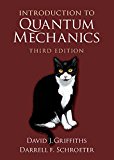 Introduction To Quantum MechanicsPhysicsISBN:9781107189638Author:Griffiths, David J., Schroeter, Darrell F.Publisher:Cambridge University Press
Introduction To Quantum MechanicsPhysicsISBN:9781107189638Author:Griffiths, David J., Schroeter, Darrell F.Publisher:Cambridge University Press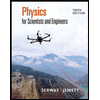 Physics for Scientists and EngineersPhysicsISBN:9781337553278Author:Raymond A. Serway, John W. JewettPublisher:Cengage Learning
Physics for Scientists and EngineersPhysicsISBN:9781337553278Author:Raymond A. Serway, John W. JewettPublisher:Cengage Learning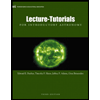 Lecture- Tutorials for Introductory AstronomyPhysicsISBN:9780321820464Author:Edward E. Prather, Tim P. Slater, Jeff P. Adams, Gina BrissendenPublisher:Addison-Wesley
Lecture- Tutorials for Introductory AstronomyPhysicsISBN:9780321820464Author:Edward E. Prather, Tim P. Slater, Jeff P. Adams, Gina BrissendenPublisher:Addison-Wesley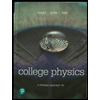 College Physics: A Strategic Approach (4th Editio...PhysicsISBN:9780134609034Author:Randall D. Knight (Professor Emeritus), Brian Jones, Stuart FieldPublisher:PEARSON
College Physics: A Strategic Approach (4th Editio...PhysicsISBN:9780134609034Author:Randall D. Knight (Professor Emeritus), Brian Jones, Stuart FieldPublisher:PEARSON

College Physics
Physics
ISBN:9781305952300
Author:Raymond A. Serway, Chris Vuille
Publisher:Cengage Learning

University Physics (14th Edition)
Physics
ISBN:9780133969290
Author:Hugh D. Young, Roger A. Freedman
Publisher:PEARSON

Introduction To Quantum Mechanics
Physics
ISBN:9781107189638
Author:Griffiths, David J., Schroeter, Darrell F.
Publisher:Cambridge University Press

Physics for Scientists and Engineers
Physics
ISBN:9781337553278
Author:Raymond A. Serway, John W. Jewett
Publisher:Cengage Learning

Lecture- Tutorials for Introductory Astronomy
Physics
ISBN:9780321820464
Author:Edward E. Prather, Tim P. Slater, Jeff P. Adams, Gina Brissenden
Publisher:Addison-Wesley

College Physics: A Strategic Approach (4th Editio...
Physics
ISBN:9780134609034
Author:Randall D. Knight (Professor Emeritus), Brian Jones, Stuart Field
Publisher:PEARSON
GCSE Physics - Vector Diagrams and Resultant Forces #43; Author: Cognito;https://www.youtube.com/watch?v=U8z8WFhOQ_Y;License: Standard YouTube License, CC-BY
TeachNext | CBSE Grade 10 | Maths | Heights and Distances; Author: Next Education India;https://www.youtube.com/watch?v=b_qm-1jHUO4;License: Standard Youtube License